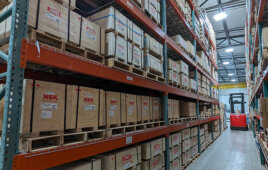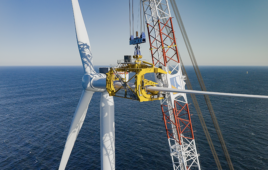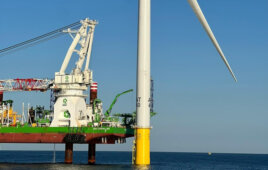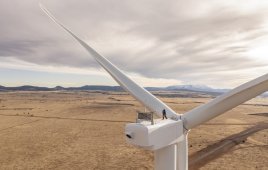Siemens Gamesa Renewable Energy (SGRE) expanded its product portfolio last month at the WindEurope Offshore 2019 Conference & Exhibition with the launch of the new Siemens Gamesa DD Flex concept and the SG 11.0-193 DD Flex offshore wind turbine. Built on the current largest offshore wind turbine in the SGRE fleet, the SG 11.0-193 DD Flex can reach a capacity of 11 MW under specific site conditions.
 “The SG 11.0-193 DD Flex is another example of how Siemens Gamesa constantly works to improve performance and provide greater value for our customers, ratepayers, and society-at-large. Digitalization allows us to increase the capacity of our current largest machine to 11 MW, boosting its annual energy production, while keeping the Levelized Cost of Energy (LCoE) down. In turn our customers can deliver more clean, reliable energy to end-users at lower overall prices,” said Andreas Nauen, CEO of the Siemens Gamesa Offshore Business Unit.
“The SG 11.0-193 DD Flex is another example of how Siemens Gamesa constantly works to improve performance and provide greater value for our customers, ratepayers, and society-at-large. Digitalization allows us to increase the capacity of our current largest machine to 11 MW, boosting its annual energy production, while keeping the Levelized Cost of Energy (LCoE) down. In turn our customers can deliver more clean, reliable energy to end-users at lower overall prices,” said Andreas Nauen, CEO of the Siemens Gamesa Offshore Business Unit.
The SG 11.0-193 DD Flex offshore wind turbine features a 193-meter diameter rotor utilizing the 94-meter long Siemens Gamesa B94 Integral Blades. Constant digital observations are processed by the control system, increasing capacity up to 11 MW. The upgraded turbine has been created based on SGRE’s deep understanding and expertise within its proven offshore direct drive technology, gained over all five product generations since being launched in 2011.
SGRE will also soon install offshore turbine number 1,000 using its patented Direct Drive technology. These turbines are installed in all major markets globally, including the UK, Germany, Denmark, The Netherlands, Belgium and Taiwan, among others. Furthermore, confirmed orders for an additional 1,000 SGRE Offshore Direct Drive turbines have been received, with installations planned for the markets mentioned above and new offshore markets including the United States, France and Japan.
News item from Siemens Gamesa
Filed Under: Components, News, Turbines





The most important improvement for wind turbines is the elimination of the power electronics. They are inefficient, delicate and expensive, and they produce dirty power. DeWind showed the way with their 8.2 and 9.2 turbines.
It is not possible to eliminate the power electronics with direct drive. Furthermore, direct drive is the heaviest and most expensive technology. It has other serious problems that cannot be solved, such as the requirement for huge quantities of expensive rare earth magnets which will become ever more expensive and difficult to obtain. Direct drive should be relegated to the museums.
But the folly of direct drive is maintained by a powerful cult whose members insist that it is more reliable than geared turbines because it has fewer parts. This is a specious argument. It ignores at least two other important factors that determine reliability: the reliability of each part and the method of mounting and operating the parts.
One reason that gearboxes have unjustly acquired a bad reputation in wind turbines is because of the way in which they are mounted in a typical wind turbine. In these arrangements, the gearbox serves as a bearing for the rotor shaft. This imposes harmful external forces on the gearbox that it should not be required to handle. Some manufacturers such as Alstom, now owned by GE, recognized this problem and invented a solution:
https://www.researchgate.net/publication/304247504_Pure_Torque_Drivetrain_Design_A_Proven_Solution_for_Increasing_the_Wind_Turbine_Reliability
Another reason is that, so far, all wind turbine gearboxes have been of the planetary type, which suffers from numerous inherent faults. That subject requires a doctoral thesis, so I won’t try to explain it here. I have written a paper on it.
A third reason is the effect of reverse or transient torque on wind turbine gearboxes. If it is not eliminated, gearboxes cannot achieve their potential life. See the excellent articles on this website about torque reversal, for instance:
https://www.windpowerengineering.com/why-gearboxes-fail-and-a-solution-to-lower-drivetrain-costs/
https://www.windpowerengineering.com/fmea-shows-transient-torque-events-damage-gearbox-bearings/
https://www.windpowerengineering.com/gearbox-model-predicts-longer-bearing-life-with-controlled-torque-reversals/
and others of which there are many, such as:
https://www.all-energy.co.uk/__novadocuments/23102
https://www.therobotreport.com/fixing-wind-power-gearboxes/
Gearboxes can be extremely reliable. A ship’s gearbox can outlast three ships if treated properly. A wind turbine gearbox can be made as reliable as that by adopting a few simple changes in the way in which it is mounted and operated, and by replacing the planetary type with the far more effective multi-branch parallel shaft type.
The only way to greatly improve wind turbines is to give up the fanatic, false belief in direct drive and come to our senses about the value of geared turbines.